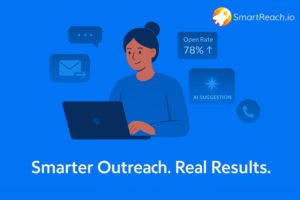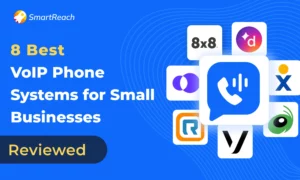How to Maximize Email Marketing Campaign Performance
Have you been trying to level up your Email marketing game?
According to Forbes, email marketing is used by 81% of B2B marketers and is the preferred communication method of 77% B2B buyers.
And the average email campaign ROI is $36 for every dollar spent.
Additionally, it allows you to reach your target audience directly instead of running multiple campaigns and wondering if it did. It is also incredibly easy on the pocket! All you need is a computer and an email list, and you are good to go.
However, for the best results, you need to incorporate the best email practices of 2025 while running your email campaigns.
This article delineates exactly how you should go about it.
14 Email marketing practices to achieve great results
Here’s how you can secure the best ROIs from your email campaigns –
#1 Build a quality email list
The quality of your email list decides the deliverability of your emails. Low deliverability harms reputation as a marketer and marks you as untrustworthy.
If your email list is outdated, erroneous, or uninterested, it might hamper the outcome of your marketing campaign. Here’s how –
An uninterested email list leads to more unopened emails.
A high number of unopened emails tells ISPs that your emails are irrelevant.
While it might not mark your ID as spam, it will increase the likelihood of your emails landing in the spam folder.
An error-laden list might increase your hard bounce rates
More bounced emails show ISPs that the quality of your list is poor and lowers your sender’s score.
Inaccurate lists might also cause your emails to fall into spam traps –
Spam traps are email addresses created to filter out senders with subpar email lists. They can cause your email ID to be blocked and have a negative effect on your email marketing campaign.
Cleanse you email database at regular intervals to avoid these issues.
#2 Seek consent before emailing
Before you begin sending out emails to your customers, ensure that they consent to receiving communication from you.
This will help you avoid getting marked as spam or landing in legal issues due to breach of data privacy laws.
You should also make it easy to unsubscribe from your emails. This shows credibility and decreases your chances of being reported to ESPs.
#3 Learn about your audience
Recent research by Emblaze shows that there is a 54.5% gap between how sellers and buyers see their core issue. Therefore, before you start sending out emails, it is important to know who exactly you are talking to. You can consider learning the following things –
- Where they are in their buyer journey.
- Their pain points
- Products they might want to try based on their previous purchase patterns.
If you offer them the solution they are searching for, your email campaigns are bound to do better.
#4 Segment your emails
Email segmentation has emerged one of the top email engagement strategies, and justifiably so. In fact, data from the Direct Marketing Association shows that segmenting your emails can bolster your revenue by 760%.
It basically means dividing your target audience into groups based on their demography, firmographics, industry type, purchase history, asset size, and other similar metrics.
This way, only content that is relevant to them makes it to their inbox and keeps them hooked.
For instance, if you are an insurance provider, the requirements will change drastically based on the industry.
If you send the same kind of email to an agribusiness and a real estate firm, you won’t be able to keep them engaged.
#5 Test your emails
Your work as a marketer isn’t just sending out emails; it is to ensure that the emails you send out get the desired results. Use A/B testing to test all parts of your emails, such as –
- The subject line
- The preview text
- The CTA.
When you have proven results, you can rest assured that the emails you are sending out will work.
#6 Choose the right metric
- Open rate
- Click-through rate
- Click-to-open rate
- Clicks per unique opens
The list of metrics in email marketing is long. But do you need all the information? Consider your end goals and track only metrics that matter.
For example –
- You can track open rates and click through rates if your campaign is trying to raise brand awareness.
- For campaigns focused on sales, tracking conversion rates and revenue per email might be a better idea.
#7 Personalize your emails
Gone are the days when generic emails used to work for a large pool of audience just fine. In 2025, you have to bring something more to the table to make a mark.
According to research by Salesforce, almost 75% of B2B buyers expect personalized content from their sellers.
Go beyond the generic “Hi, [first name]” and send out emails that reflect their preferences and address their pain points. Personalizing your email campaigns this way can help you get a much better response.
#8 Quality over quantity
We get it- email marketing is pretty affordable, resulting in an urge to bombard your target audience with an email every day.
Here’s the thing – it won’t work. In fact, too many emails can result in hordes of irate customers clicking on that “unsubscribe” button.
To prevent that from happening, focus on maintaining good quality via consistent brand tone and well-written content.
However, just because you are focusing on quality doesn’t mean you will abandon your customers. Create a routine to send out emails at regular intervals so that you can keep promoting your business without overwhelming your customers.
#9 Timing is everything
Research shows that the best days to send out marketing emails are – Tuesdays, Wednesdays, and Thursdays.
The best timings are between 10 AM and 12 PM and then 1PM and 3PM.
Avoid sending emails early in the morning and later in the day.
These timings aren’t the best for engagement as your target audience is either just settling in or tired from an entire day of work. You should also avoid sending marketing emails on weekends as it is their personal time.
#10 Create catchy subject lines and body copy
Your target audience receives a number of emails each day. To ensure they open yours, you have to reel them in.
A great way to do so is to come up with creative email subject lines that draws their attention. A few examples of such creative subject lines could be –
- Offers such as “Limited Time Offer” and “Up to 30% off.”
- Direct reference to their pain points, like “Want better ROIs?”
Additionally, ensure that your preview text complements the subject lines. The preview text is basically the text you see next to the subject line. If you don’t create it carefully, your customer might see irrelevant content next to it. This will drop the open rates drastically.
#11 Create responsive designs
Did you know that 67% of Gen Z and 59% of millennials use email on their phones?
This means a huge chunk of your target audience is reading your message on a screen much smaller than your normal computer.
This makes it necessary to incorporate responsive designs within your email campaigns.
Even the best-written messages are of little use if it’s barely legible to the target audience. Ensure that your content has a minimum of 14 to 16px in body text and 22px or more in headlines.
#12 Offer double opt-ins
Offering double opt-ins on your website is an underrated way to increase the efficiency of your email campaigns.
While there’s no denying that single opt-ins are simpler to set up, double opt-ins keep away scammers while also reconfirming the client’s interest in subscribing to your content.
#13 Automate your emails
Did you know that automated emails result in 320% more revenue compared to non-automated ones?
Automating your email campaigns can increase their efficiency by several notches. You can use an automation tool to handle these tasks effortlessly instead of tracking every customer and sending follow-up texts manually.
You can incorporate AI in email campaigns to make the process even more seamless. AI can also help you –
- Automate processes
- Generate personalized content
- Keep track of KPIs
- Create catchy subject lines and so much more.
#14 Provide actionable CTA
Your prospects shouldn’t have to toil to buy your offerings.
Therefore, besides making a CTA catchy, you also need to ensure that it guides your customer on the next course of action.
That way, you can capitalize on their impulse to subscribe to your product or service.
Additionally, use a thumb friendly 44x44px CTA with enough space to avoid accidental clicking.
Conclusion
Maximizing your email campaigns might seem hard at first glance.
But don’t worry.
Just follow the tips and tricks we listed, and you will get the hang of it in a jiffy.
Now pull up your socks and set forth on your marketing campaign like a wiz.
Good luck!
F.A.Qs
Q. Why should it be easy to unsubscribe?
When customers find it hard to unsubscribe, they are more likely to report your email as SPAM. Additionally, easy unsubscribe is an important guideline of the CAN-SPAM and has penalties for not complying.
Q. Why should I use AI in email marketing?
Using AI in email campaigns significantly cuts down the usage of resources in follow-ups, personalization, and other tasks. This allows you to use your resources for more important tasks.
Q. What is the future of email marketing?
Segmentation and personalization with AI are going to be prominent in the future of email marketing. These methods will help marketers create emails that fit the needs and preferences of the buyers perfectly.
Q. What mistakes should I avoid?
Here are a few mistakes you should avoid in your campaigns –
- Sending generic emails.
- Not testing emails before the campaign.
- Not addressing issues or pain points.
Q. How to make my email content stand out?
Here are a few ways to make your email content shine –
- Make the content short and to-the-point.
- Come up with creative subject lines.
- Use interactive emails.
- Make the email text legible.



